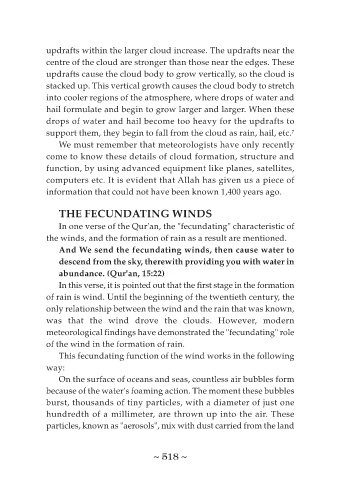Page 493 - Learning from the Qur'an
P. 493
updrafts within the larger cloud increase. The updrafts near the
centre of the cloud are stronger than those near the edges. These
updrafts cause the cloud body to grow vertically, so the cloud is
stacked up. This vertical growth causes the cloud body to stretch
into cooler regions of the atmosphere, where drops of water and
hail formulate and begin to grow larger and larger. When these
drops of water and hail become too heavy for the updrafts to
support them, they begin to fall from the cloud as rain, hail, etc. 7
We must remember that meteorologists have only recently
come to know these details of cloud formation, structure and
function, by using advanced equipment like planes, satellites,
computers etc. It is evident that Allah has given us a piece of
information that could not have been known 1,400 years ago.
THE FECUNDATING WINDS
In one verse of the Qur'an, the "fecundating" characteristic of
the winds, and the formation of rain as a result are mentioned.
And We send the fecundating winds, then cause water to
descend from the sky, therewith providing you with water in
abundance. (Qur'an, 15:22)
In this verse, it is pointed out that the first stage in the formation
of rain is wind. Until the beginning of the twentieth century, the
only relationship between the wind and the rain that was known,
was that the wind drove the clouds. However, modern
meteorological findings have demonstrated the "fecundating" role
of the wind in the formation of rain.
This fecundating function of the wind works in the following
way:
On the surface of oceans and seas, countless air bubbles form
because of the water's foaming action. The moment these bubbles
burst, thousands of tiny particles, with a diameter of just one
hundredth of a millimeter, are thrown up into the air. These
particles, known as "aerosols", mix with dust carried from the land
~ 518 ~

